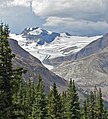Mountain in Canada
Mount Habel is a 3,073-metre (10,082-foot) mountain summit located in Banff National Park on the Continental Divide along the border of Alberta and British Columbia in the Waputik Mountains , part of the Canadian Rockies . It was named in 1986 after Jean Habel.[ 2] [ 3] Wapta Icefield which surrounds Mount Habel.[ 5]
Geology
Like other mountains in Banff Park, Mount Habel is composed of sedimentary rock laid down during the Precambrian to Jurassic periods.[ 6] Laramide orogeny .[ 7]
Climate
Based on the Köppen climate classification , Mount Habel is located in a subarctic climate zone with cold, snowy winters, and mild summers.[ 8]
Gallery
See also
References
^ "Topographic map of Mount Habel" . opentopomap.org . Retrieved 2022-06-19 .^ a b c "Mount Habel" . cdnrockiesdatabases.ca . Retrieved 2019-09-14 .^ a b c d "Mount Habel" . Bivouac.com . Retrieved 2019-09-14 .^ a b "Mount Habel (BC)" . Geographical Names Data Base Natural Resources Canada . Retrieved 2019-09-14 .^ W., Boles, Glen (2006). Canadian mountain place names : the Rockies and Columbia Mountains ISBN 9781894765794 OCLC 244770225 . {{cite book }}: CS1 maint: multiple names: authors list (link )^ Belyea, Helen R. (1960). The Story of the Mountains in Banff National Park (PDF) . parkscanadahistory.com (Report). Ottawa: Geological Survey of Canada. Archived (PDF) from the original on 2015-10-02. Retrieved 2019-09-13 . ^ Gadd, Ben (2008). Geology of the Rocky Mountains and Columbias . ^ Peel, M. C.; Finlayson, B. L.; McMahon, T. A. (2007). "Updated world map of the Köppen−Geiger climate classification" . Hydrol. Earth Syst. Sci . 11 (5): 1633– 1644. Bibcode :2007HESS...11.1633P . doi :10.5194/hess-11-1633-2007 ISSN 1027-5606 .
External links
Ranges Mountains Passes Glaciers Rivers Peoples Parks and
International National Provincial (AB) Provincial (BC)
Ski resorts Communities Ecozone and






